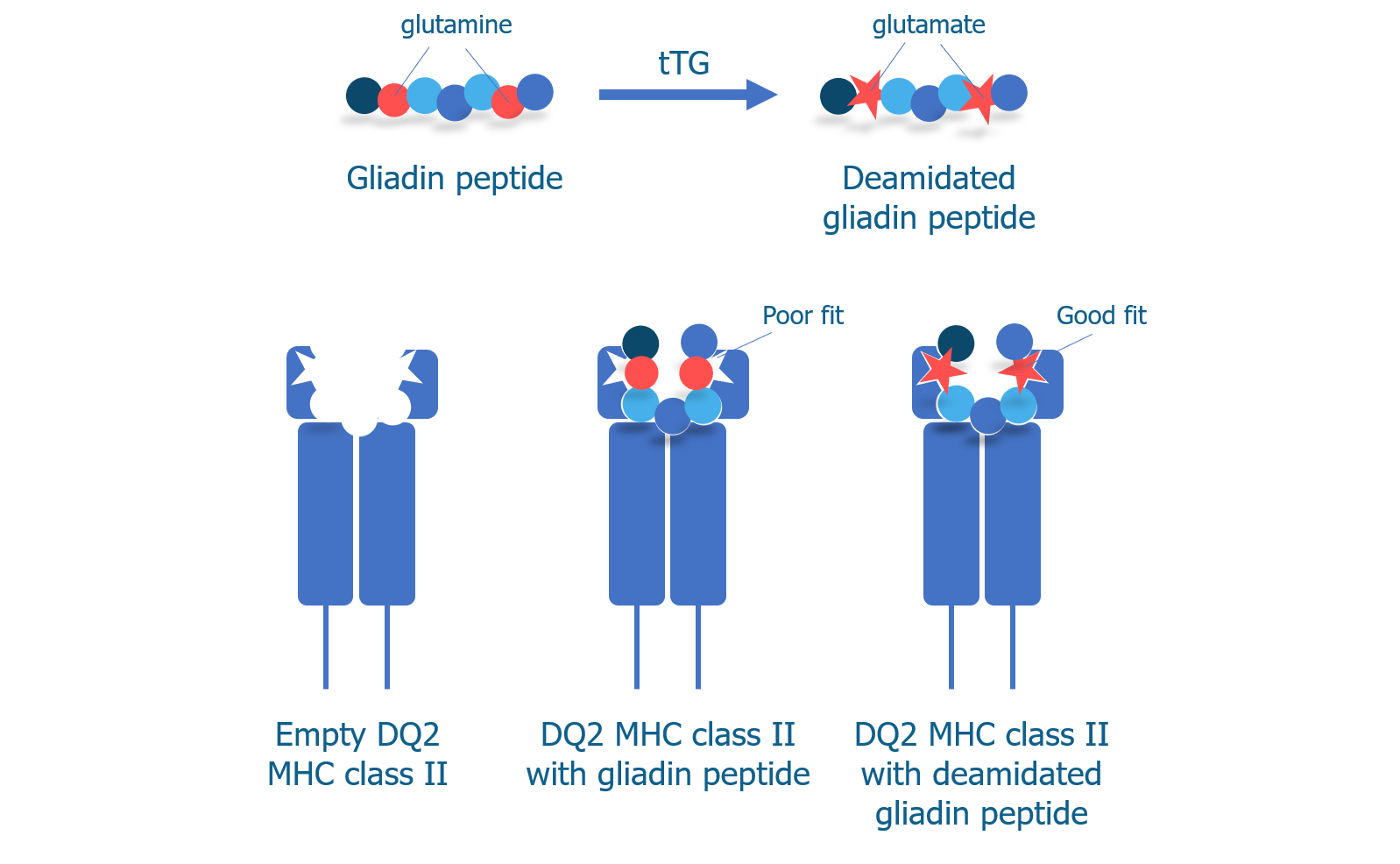In addition to HLA-DQ2 and HLA-DQ8 haplotypes, an enzyme called tissue transglutaminase or tTG (also known as transglutaminase 2 or TG2) also influences how gliadin peptides are presented to CD4+ T cells.
You may have heard of tTG because of the tTG-IgA test, which is used by many doctors when testing for celiac disease.1 tTG is a multifunctional enzyme—a protein that can change one type of molecule to another. In celiac disease, the enzyme tTG changes an amino acid called glutamine into another amino acid called glutamate through a chemical reaction called deamidation.

As we discussed above, gliadin (one of the proteins in gluten) has a many glutamine amino acids. When these glutamines are changed to glutamates, the properties of the gliadin peptide change as well. Deamidated gliadin fits better than non-deamidated gliadin in the grooves of the DQ2/DQ8 MHC class II protein. Because it fits better, the MHC class II proteins present deamidated gliadin more efficiently to CD4+ T cells, which results in enhanced immunogenicity (a stronger the immune response).
So far, we have learned how CD4+ T cells can mistakenly recognize gliadin peptides and initiate an immune response:
- Gliadin (a protein in gluten) is not completely digested in the intestine
- Gliadin peptides are deamidated by tissue transglutaminase (tTG)
- Deamidated gliadin peptides are presented as antigens by HLA-DQ2 or HLA-DQ8
- CD4+ T cells recognize the deamidated gliadin peptide as a threat and begin an immune response
In addition to T cells, there is another type of immune cell that plays an important part in celiac disease. We will talk about B cells and antibodies in the next section.
REFERENCES
- Rubio-Tapia A, Hill ID, Kelly CP, Calderwood AH, Murray JA, American College of G. ACG clinical guidelines: diagnosis and management of celiac disease. Am J Gastroenterol. 2013;108(5):656-676.
GLOSSARY
Antibodies – Y-shaped proteins that recognize foreign pathogens. Made by B cells. Also called immunoglobulins.
B cell – A type of adaptive immune cell. Also called B lymphocyte.
CD4 – A co-receptor on the surface of helper T cells.
Cytokines – Small proteins that are made and released by immune cells. Allows cells to send signals and provide instructions to other cells.
Deamidation – A chemical reaction that can convert a glutamine amino acid to a glutamate amino acid.
Enzyme – A protein that can change one type of molecule to another.
Gliadin – One of the wheat proteins that forms gluten. Responsible for triggering an immune response in patients with celiac disease.
Gluten – A type of protein found in cereal grains. Wheat gluten is made of two proteins called gliadin and glutenin.
Haplotype – Variations in HLA genes that produce different MHC class II proteins.
Immunogenicity – The ability of an antigen to induce an immune response.
MHC class II protein – Major histocompatibility complex class II protein. Found on the surface of antigen presenting cells. Presents peptides to CD4+ T cells.
T cell – A type of adaptive immune cell. Also called T lymphocyte.
Tissue transglutaminase (tTG) – An enzyme that deamidates gliadin peptides causing them to be more immunogenic. Also the target of auto-antibodies in patients with celiac disease.
Share this Post
